San Francisco Municipal Railway fleet
With five different modes of transport from many different vendors, the San Francisco Municipal Railway or Muni as it is commonly known, runs one of the most diverse fleets of vehicles in the United States. Roughly 800 buses (500 diesel buses and 300 trolleybuses), 200 streetcars and 40 cable cars see active duty. Muni's cable cars constitute the oldest and largest such system remaining in service in the world and is the only one still running with manually operated cars in street traffic. Its fleet of electric trolleybuses is the largest in the United States. The 30- and 40-ft diesel/hybrid buses are numbered in the 8000 series, the 60-ft articulated diesel/hybrid buses in the 6000 series, the 40-ft trolleybuses in the 5000 series, the 60-ft articulated trolleybuses in the 7000 series, and the streetcars in the 1000 and 2000 series. Muni is in the process of replacing its motor coach fleet - the first of which was procured in 1915[1] - with diesel-electric hybrid buses. A summary of the current and historic vehicles follows.
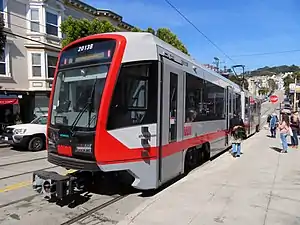
Summary
Current fleet
All buses are accessible at all stops. All streetcars are accessible; however, some surface stops on the E and F lines, and many Muni Metro surface stops, are not accessible. Cable cars are not accessible.
| Model | Fleet Series (Year Built) Quantity[2] | Division | Image | Notes |
|---|---|---|---|---|
| Neoplan AN440 (40 ft. High Floor Diesel Bus) | 8101 (1999) 8102-8235 (2000) 8301-8371 (2002) 206 buses | Islais Creek (training, reserve fleet) |  | 34 buses were rebuilt in 2010-2011, and 80 more rebuilt in 2013.[3][4] Being retired, although some units used as reserve / training buses. 8350 preserved by MUNI. |
| Orion VII (30 ft. Low Floor Diesel-electric Hybrid Bus) | 8501-8530 (2007) 30 buses | Woods |  | To be replaced.[5] |
| New Flyer Industries XDE40 (40 ft. Low Floor Diesel-electric Hybrid Bus)[6] | 8601-8662, 8701-8750 (2013) 8751-8780 (2017) 8800-8901 (2016-2017) 8902-8969 (2018-2019) 312 buses | Woods, Kirkland |  | |
| New Flyer Industries XDE60 (60 ft. Articulated Low Floor Diesel-electric Hybrid Bus) | 6500-6554 (2015) 6560-6697 (2015-2018) 6700-6730 (2015-2016) 224 buses | Flynn, Islais Creek |  | |
| New Flyer Industries XT40 (40 ft. Low Floor Trolleybus) | 5701-5885 (2017-2019) 185 buses[7] | Presidio, Potrero |  | |
| New Flyer Industries XT60 (60 ft. Articulated Low Floor Trolleybus) | 7201-7293 (2015-2018) 93 buses |
Potrero |  | Option for the final 33 units exercised in July 2016[8] |
| Breda LRV2 (1400-1476), Breda LRV3 (1477-1550)[9] (High floor Light-Rail Vehicle) | 1400-1535 (1996-2001), 1536-1550 (2003) 151 streetcars[10] | Green, Muni Metro East | 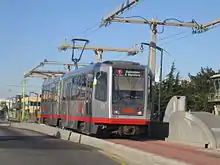 | Three units retired. |
| Siemens S200 LRV4 (High floor Light-Rail Vehicle) | 2001-2219 (2016-2028) 219 streetcars (plus up to 45 option) | Green, Muni Metro East, Cameron Beach Yard |  | |
| PCC (High floor historic streetcar) | 1006-1011, 1015, 1040, 1050-1053, 1070-1080 (1946-1952) 32 streetcars [11] | Cameron Beach Yard |  | 33 units were acquired by Muni, but 1 were retired. 1055-1063 were purchased from SEPTA. 1070-1080 were purchased from NJ Transit. Additional units were in storage. |
| Peter Witt (High floor historic streetcar) | 1807, 1811, 1814-1815, 1818, 1834, 1856, 1859, 1888, 1893, 1895 (1928) 11 streetcars[11] | Cameron Beach Yard |  | |
| Various (High floor historic streetcar) | (1912-) 7 streetcars[11] | Cameron Beach Yard | ||
| Various (High floor historic streetcar) | (Unknown) N/A[11] | Various | ||
| Various (High floor cable car) | Powell: 1-28 California: 49-60 (1873-) 40 cable cars | Cable Car |  | |
Historical bus fleet
The following shows the buses previously operated by the SFMTA. Some of these coaches have been preserved in the historic fleet, donated to trolley museums, or auctioned.
| Model | Fleet Nos. (Year Built) | Preserved Unit(s) | Qty | Last retired | Image | Notes |
|---|---|---|---|---|---|---|
| Orion VII (40' HEV) | 8401 (2006) 8402-8456 (2007) |
8426 | 56 | 2020 |  |
|
| ETI 14TrSF | 5401-5402 (1999) 5403-5640 (2001-2004) |
5538[12] | 240 | 2019[12][13] |  |
|
| Neoplan AN460 | 6200-6225 (2000), 6226-6299 (2001), 6401-6424 (2002) |
6255 | 124 | 2018 |  |
Some units were rebuilt in 2010-2011. |
| NABI 416.12 | 8001-8045 (1999) | None | 45 | 2016 |  |
|
| ETI 15TrSF | 7101 (2000), 7102-7133 (2003) |
None | 33 | 2016[14] | 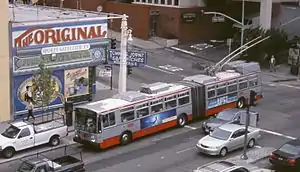 |
2002 models |
| New Flyer Industries E60 | 7000-7059 (1992-1994) | 7031[15] | 60 | 2015 |  |
First 60-foot articulated trolleybus fleet. 7031 was planned to be auctioned in 2019, but the auction was withdrawn.[16] |
| New Flyer Industries D60 | 9101-9124 (1990-1991) | 9120[15] | 24 | 2014 |  |
Second articulated bus fleet. 9120 was planned to be auctioned in 2019, but the auction was withdrawn.[17] |
| Gillig Corporation Phantom 40' | 2801–2845 (1993) | 2840 (training only) | 45 | 2013[18] |  |
Bought from AC Transit in 2005 for reserve fleet. 2840 was planned to be auctioned in 2019, but the auction was withdrawn. It has been used as a training bus since April 2018. |
| Orion Bus Industries I Citycruiser | 9001-9045 (1990) | 9010 | 45 | 2008 |  |
9030 was converted to Mobile Commander Center CC1. |
| New Flyer Industries D40 | 8801-8850 (1988), 8901-8956 (1989) |
8926 | 106 | 2007 |  |
|
| Flyer Industries E800 | 5003-5345 (1976-1977) | 5300, 5345 | 343 | 2007 |  |
5148 is at Seashore Trolley Museum. |
| Flyer Industries D902 | 4500-4679 (1984) | 4574 | 180 | 2003 |  |
4574 was damaged while being delivered. A second 4574 was built as a Flyer D901 and delivered in its place. |
| MAN AG SG-310-18-3A | 6000-6099 (1984) | 6099 | 100 | 2002 |  |
First 60-ft articulated bus. 6020 and 6090 are under private ownership and are commonly seen at Burning Man.[19] |
| Flyer D900 | 3XXR, 6XXR (1980) | None | 110 | 2000 | Bought from SamTrans in 1994; reserve fleet only. | |
| Flyer E700A | 5001 (1972), 5002 (1973) |
None | 2 | 1999 | Pilot buses for later E800 fleet (5003-5345) | |
| GM New Look | 3000-3389 (1969-1970) | 3287 | 390 | 1994 |  |
3000, 3210, 3226, and others are under private ownership. 3270 is preserved at the Pacific Bus Museum. |
| Flxible New Look | 4000-4009 (1969) | 4009 | 10 | 1991 | ||
| AM General Metropolitan 9635-6 | 4100-4199 (1975) | 4154 | 100 | 1990 |  |
|
| Grumman 870 | 4030-4054 (1980) | None | 25 | 1985 | Most were scrapped around 1986, though some remained as reserve buses until 1989. | |
| Twin Coach 44TTW | 570-659 (1949-1950) | None | 90 | 1977[1] | ||
| St. Louis Car Company Job 1704/Job 1731 | 501-509 (1939), 510-525 (1947) |
506 | 25 | 1977[1] | 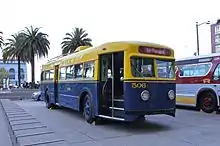 |
|
| Marmon-Herrington TC40 | 526-549 (1948) | None | 25 | 1977[1] | ||
| Marmon-Herrington TC44 | 550–569, 660–710 (1948-1949) | None | 70 | 1977[1] | 559 was originally used on the Dayton, Ohio, trolleybus system. | |
| Marmon-Herrington TC48 | 711–849 (1950-1951) | 776 | 139 | 1977[1] | %252C_September_2017.JPG.webp) |
|
| White 784 | 042-062 (1938) | 042 | 20 | 1975[1] |  |
060 was bought by a private owner. |
| Mack C-49-DT | 2100-2199 (1955), 2200-2269 (1956), 2300-2369 (1957), 2400-2469 (1958), 2500-2569 (1959), 2600-2669 (1960) |
2230 | 450 | 1974[1] |  |
2617 was bought by a private owner. |
| White 798 | 075-0155, 0166-0454 (1944-1948) |
0392, 0419 | 368 | 1969 | ||
| Twin Coach 44-D | 0156-0165 (1947) | 0163 | 10 | 1953[1] | ||
| ACF 26-S | 063–072 (1940) | None | 10 |
Divisions
| Division | Opened | Number of Vehicles | Vehicle Type | Location | Image | Notes |
|---|---|---|---|---|---|---|
| Presidio Division | 1912 | 132 | 40-foot trolleybuses | Bush and Presidio |  |
The first yard built for Muni, originally used for the Geary streetcar lines |
| Potrero Division | 1914 | 146 | 40-foot and 60-foot trolleybuses | 17th & Bryant |  |
|
| Woods Division | 1975 | 251 | 30-foot and 40-foot hybrid buses | 22nd & Indiana |  |
|
| Flynn Division | 1989 | 119 | 60-foot hybrid buses | 15th & Harrison |  |
|
| Kirkland Division | 1950 | 91 | 40-foot hybrid buses | Powell & Beach |  |
|
| Balboa Park complex | 1901 (rebuilt 1970s) | ~200 | LRVs and historic streetcars | San Jose & Geneva |  |
Includes Green Division, Geneva Division, and the closed Geneva Upper Yard. Geneva Division was renamed Cameron Beach Yard in 2011.[20] |
| Muni Metro East | 2008 | 80-100 | LRVs and historic streetcars | Cesar Chavez & Illinois |  |
|
| Cable Car | 1890s | 50 | Cable cars | Washington & Mason |  |
Includes the San Francisco Cable Car Museum |
| David Pharr Restoration Facility | 1982 | Duboce and Buchanan | 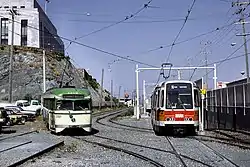 |
Small outdoor yard used for restoration work and to temporarily store Muni Metro trains. Pharr was a self-taught volunteer with Market Street Railway.[21][22] | ||
| Marin | 1982 | Marin & Indiana |  |
Used for long-term storage of disused streetcars, cable cars, and buses | ||
| Islais Creek | 2013 | 105 | 60-foot hybrid buses | Marin & Indiana |  |
Originally an open storage yard, it was replaced with an enclosed building in 2017. The $127 million facility, intended to replace the aging Kirkland Yard, has attracted local criticism. It was promised to include a public meeting room, a publicly-accessible lobby with historical exhibits, and a shoreline park with signage; however, the lobby was dropped for the plans and funding was not allocated for the signage.[23] |
| Muni Yards and Divisions 1 2 3 4 5 6 7 8 9 10 |
Buses
Diesel buses
Muni's active diesel fleet contains coaches ranging from thirty to sixty feet in length. For the last complete fleet replacement cycle Muni bought from three manufacturers, NABI, Neoplan and Orion, all of whom no longer sell buses in the U.S. (NABI has merged into New Flyer, Neoplan has left the North American market, and Daimler has shut down Orion). Muni has since purchased 40 ft. and 60 ft. buses from New Flyer with options to replace the remainder of the fleet in those sizes.
All of Muni's current active diesel buses have met ADA standards since 1980. In 1984, Muni received its first 60-foot (18 m) articulated buses, which are used on high-ridership routes. In December 2007, Muni acquired a double-decker diesel bus for testing purposes, but did not purchase a revenue fleet.[24] Muni fueled its diesels with a B20 (20% bio, 80% diesel) bio-diesel blend until late 2015, when that was replaced with renewable "green" diesel fuel.[25]
Hybrid-electric diesel buses
Since 2007 Muni's new diesel bus purchases have been for diesel-electric hybrids. Because of their electric motor propulsion these buses can climb hills just as well as trolleybuses without being limited to the overhead grid. Hybrids are also known for averaging more miles between road calls - which is where a mechanic services a transit vehicle on the street[26] - than standard diesels.[27] One of the vehicles was briefly outfitted with wireless internet as a demonstration project.[28] However, these buses were not operated on the 44-O'Shaughnessy and 54-Felton lines for several months as vandals consistently flipped a battery switch towards the back of the vehicle in San Francisco's Hunters Point area, disabling the bus.[29] By 2035, Muni plans to replace its entire motor coach fleet with all-electric buses.[30]
Battery-electric buses
In 2018, the SFMTA Board voted to only purchase all-electric buses beginning in 2025, with the last non-electric buses retired by 2035. Muni had not previously bought battery-electric buses (BEBs) because they were not proven on steep hills and on high-ridership routes. A small number of electric buses will be tested in 2019.[31] In November 2019, Muni executed contracts with NFI Group (for $4.5 million), BYD Auto ($3.5 million), and Proterra, Inc. ($5.3 million) to procure three BEBs from each vendor as a pilot program to evaluate their performance and test future bus features. Each contract has an option for up to three more BEBs.[32]
Electric trolleybuses

Muni's fleet of electric trolleybuses (ETBs) is the largest in the nation[33] and serves many parts of the city. ETBs were very popular in the United States in the middle of the 20th century. Today, San Francisco is one of only five cities in the United States with an operational ETB fleet,[33][34] but they play a major role in the Muni system, in part because of the city's many steep hills. Although their overhead wires are sometimes considered unsightly, ETBs are able to climb grades much steeper than conventional, non-cable streetcars and are quieter (particularly when climbing hills) and cleaner than diesel- or hybrid buses. The steepest grade on the Muni trolleybus system, 22.8% in the block of Noe Street between Cesar Chavez Street and 26th Street on route 24-Divisadero,[35] is the steepest grade on any existing trolleybus line in the world,[36]:127 [37][38] and several other sections of Muni ETB routes are among the world's steepest.[39] Muni has operated trolleybuses since 1941 and the mode has been present in San Francisco since 1935—initially a line built and operated by the Market Street Railway and later taken over by Muni.[33] Conversion of some existing diesel bus lines has been proposed.
In 1992, Muni tested its first 60-ft articulated trolleybus, the New Flyer E60, which was the first in the trolleybus fleet to have a wheelchair lift. The E60s were used on high-ridership trolleybus routes and started service in 1993.
Muni's active ETB fleet consists of articulated coaches from New Flyer (XT60), as well as standard 40 ft coaches from New Flyer (XT40). Historically, Muni ran ETBs from Brill, the St. Louis Car Company, Twin Coach, Marmon-Herrington, Flyer (E800 and E60) and Electric Transit, Inc. (ETI) (Skoda/AAI 14TrSF and 15TrSF).[40]
Cable cars
Around the turn of the twentieth century, there were numerous cable car lines providing service to many sections of the city. Some of those cable cars are built by Muni themselves.[41] Currently only three lines and forty cars remain.
Streetcars
Contemporary light rail vehicles
The Muni Metro has run multiple types of light rail vehicles. Originally, 131 Boeing-Vertol cars, which Muni designated LRV1, were used. However, these proved to be extremely troublesome and were phased out of service beginning in 1997. The Boeing cars were replaced by 151 Italian-built Breda LRV2 and LRV3 models. Initially, the Breda vehicles were hailed as more reliable and easier to service than their predecessors. However, deferred maintenance and design defects have taken their toll on them.
Muni has expanded its fleet with new Siemens light rail vehicles; the 151 Bredas will be replaced one-for-one starting in 2021. The first phase of 68 Siemens S200 LRV4s (for fleet expansion: 24 Central Subway + 40 Option 1 + 4 Phase W) were delivered between 2017 and 2019, ahead of the scheduled opening of the Central Subway.[42] SFMTA's initial contract with Siemens called for a total of 260 cars to be delivered: 175 in the base order (151 of which are to replace the Bredas, and 24 for fleet expansion to accommodate anticipated ridership via the Central Subway), 40 as Option 1, and 45 as Option 2.[43] Four more Siemens LRV4s were ordered in June 2017 for Phase W, which anticipates expanded service to Chase Center, using the Mission Bay Transportation Improvement Fund.[44] As of November 2019, Option 1 has been exercised,[45] so 219 LRV4s are on order or have been delivered (175 + 40 + 4);[42] up to 45 more LRV4s may be ordered if Option 2 is exercised.[46]
The first LRV4 went into revenue service on November 17, 2017.[47]
Inactive/retired LRVs
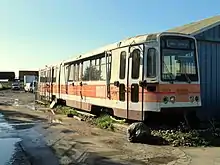
The US Standard Light Rail Vehicle was an attempt at a standardized light rail vehicle (LRV) promoted by the United States Urban Mass Transit Administration (UMTA) and built by Boeing Vertol in the 1970s. Part of a series of defense conversion projects in the waning days of the Vietnam War, the LRV was seen as both a replacement for older PCC streetcars in many cities and as a catalyst for new cities to construct light rail systems. The USSLRV was marketed as the Boeing LRV and is usually referred to as such. The USSLRV was purchased by both Muni and the MBTA (Boston), but no other public transportation system in the United States purchased USSLRVs. Under the settlement terms of a lawsuit between Boeing Vertol and MBTA, MBTA was granted the right to reject the last 40 cars. The completed MBTA cars sat in storage until Muni purchased 31 of them.
After the last LRV1 was retired in 2001, Muni stored two cars (1264 and 1320) at the Cameron Beach Yard (formerly the Geneva Streetcar Yard) for potential restoration and preservation by the Market Street Railway, but they declined to do so and both were scrapped in April 2016.[48][49] Two LRV1s are preserved in museums:
- 1213 (since 2000), at the Oregon Electric Railway Museum
- 1258, at the Western Railway Museum
In addition, No. 1271 is used as an office trailer in a Bay Area scrapyard.[50]
The succeeding Breda LRV2/LRV3 fleet of 151 cars is scheduled to phase into retirement between 2021, when the oldest cars are 25 years old, and completely retire by 2027. 25 years is considered the useful lifespan of light rail vehicles, per the FTA and Muni.[51]:3 Since delivery of the Siemens LRV4 fleet has been ahead of schedule, Muni is considering an earlier retirement for some of the oldest Breda cars.[52]
| Model | Year Built | Fleet Series | Quantity | Year of retirement | Notes | Image |
|---|---|---|---|---|---|---|
| Boeing USSLRV (LRV1) | 1978 | 1200–1299 | 131 | 1996–2001 | 1222 and 1252 were damaged during subway testing on Nov 12, 1979; these cars were scrapped for parts used to finish ex-MBTA 3565, subsequently renumbered to Muni 1252 (II) and delivered on Jan 27, 1982.[36]:125 1212 wrecked into 1255 at the Van Ness junction in the Muni Metro subway in 1987. The good halves were converted into a new 1255 and the bad halves were scrapped in February 1994. |  |
| 1977 | 1300–1329 | 31 cars in total. The first car from the rejected MBTA lot (ex-3565) was procured to replace two wrecked cars from the original order of 100 and re-assigned number 1252.[36]:125 The other 30 ex-MBTA cars were numbered 1300–1329 and entered service in 1981–1984. |  | |||
| Breda LRV2 | 1996–1999 | 1400–1476 | 151 | 2021–2027[51] | Two LRV2s (#1407 & #1433) collided at West Portal in 2009;[53] the undamaged halves were mated with spares from #1429 & 1435.[54] The rebuilt 1407 (1429A/1407B) & 1433 (1435A/1433B) were returned to service; 1429 (1407A/1429B) & 1435 (1435B/1433A) were beyond repair and retired early. | 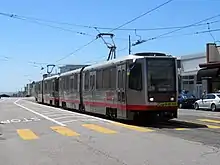 |
| Breda LRV3 | 1999–2003 | 1477–1550 | 1494 was hit by a truck on July 20, 2017 [55] and has been cannibalized for parts at Muni Metro East. | |||
| Siemens S200 SF (LRV4) | 2016+ | 2001+ | 219 (264) | — | Entered revenue service in 2017. 219 firm orders; unexercised option for 45 additional. |  |
Historic streetcars
Historic streetcars are run on the F Market & Wharves line. Introduced as a regular, year-round service in 1995, the F-line heritage streetcar service started out 12 years earlier as a temporary, replacement tourist attraction for the cable cars – known as the San Francisco Historic Trolley Festival – during an almost two-year suspension (1982–84) of all cable-car service to permit major infrastructure rebuilding to take place. The F-line fleet is composed mostly of PCC cars bought secondhand from Philadelphia and New Jersey. The cars are painted in liveries from cities around the world, as well as 1920s-vintage Peter Witt cars from Milan. In addition, Muni operates streetcars from around the world which were bought or donated to the transit agency. The vintage fleet is looked over by Market Street Railway but owned and operated by Muni.
First batch (overhauled by Morrison-Knudsen)
This shows the active PCCs entering service 1995 or before. Most are single-ended; cars 1007, 1010, and 1015 are double-ended "Torpedo" cars. All of these cars were rehabilitated by Morrison-Knudsen before entering revenue service. Car 1054 (original 2121) was damaged beyond repair following an accident on November 16, 2003 and it is stored awaiting scrapping.[56][57][58]
In 2014, Muni sent 1056, the first from the original batch of sixteen to be overhauled at Brookville Equipment Corporation.[59] The entire first batch of sixteen is scheduled to be rebuilt at Brookville; the next cars to be sent were 1051, 1060, and 1059 in that order;[60][61] followed (in indeterminate order) by 1055, 1062, and 1063.[62] The first streetcar to re-enter service, 1051, was re-dedicated to Harvey Milk in March 2017, and was followed back into service by 1056.[63]
| PCC # | City/System Represented | Current Status | Notes | Image |
|---|---|---|---|---|
| 1007 | Philadelphia Suburban Transportation Company | Out of service | Built in 1948 for Muni. Retired in 1982 and stored until 1994. Restored in 1995. Previously painted in Muni's Breda LRV livery; repainted into the present livery in 1997. | |
| 1010 | San Francisco Municipal Railway (1939 livery) |
Out of service | Built in 1948 for Muni. Retired in 1982 and stored until 1994. Restored in 1996. Undergoing restoration at Brookville. |  |
| 1015 | Illinois Terminal Railroad | Out of service | Built in 1948 for Muni. Retired in 1982 and stored until 1994. Restored in 1995. Undergoing restoration at Brookville. | 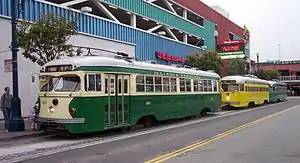 |
| 1050 | St. Louis Public Service Company (1950 livery) |
In service | Built in 1948 for Philadelphia Transportation Company (later SEPTA) as 2119. Acquired by Muni in 1992 and re-entered service in 1995 bearing legacy San Francisco "Wings" livery (1951). Went for rebuild in late 2016. 1050 was repainted into a tribute livery for Saint Louis. | .jpg.webp) |
| 1051 | San Francisco Municipal Railway (1963 livery) |
In service | Built in 1948 for Philadelphia Transportation Company (later SEPTA) as 2123. Acquired by Muni in 1992 and re-entered service in 1995. Dedicated for Supervisor Harvey Milk in 2008, later appearing in the film Milk.[65][66][67] Sent to Brookville for rebuild; returned in 2016[62] and re-entered service in 2017.[63] | 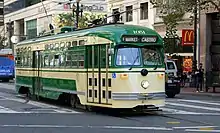 |
| 1052 | Los Angeles Railway (1937 livery) |
In service | Built in 1948 for Philadelphia Transportation Company (later SEPTA) as 2110. Acquired by Muni in 1992 and re-entered service in 1995. | .jpg.webp) |
| 1053 | NYC Board of Transportation (Brooklyn, NY) |
In service | Built in 1947 for Philadelphia Transportation Company (later SEPTA) as 2721. Originally configured with a separate conductor's booth until 1955. Acquired by Muni in 1992 and re-entered service in 1995. Rebuilt Brookville (2018).[68] |  |
| 1055 | Philadelphia Transportation Company (1947 livery) |
In service | Built in 1948 for Philadelphia Transportation Company (later SEPTA) as 2122. Acquired by Muni in 1992 and re-entered service in 1995. Rebuilt Brookville (2017),[62] repainted to as-delivered Philadelphia livery.[69][70] |  |
| 1056 | Kansas City Public Service Company | In service | Built in 1948 for Philadelphia Transportation Company (later SEPTA) as 2113. Acquired by Muni in 1992 and re-entered service in 1995. Out of service after a cracked bolster was discovered in 2011;[59][71] rebuilt by Brookville and returned to Muni in 2016,[72] re-entered service in 2017.[63] |  |
| 1057 | Cincinnati Street Railway | In Service | Built in 1948 for Philadelphia Transportation Company (later SEPTA) as 2138. Acquired by Muni in 1992 and re-entered service in 1995. Rebuilt by Brookville in 2018-2019. |  |
| 1058 | Chicago Transit Authority | In Service | Built in 1948 for Philadelphia Transportation Company (later SEPTA) as 2124. Acquired by Muni in 1992 and re-entered service in 1995. Previously painted in CTA's 1950s green and cream livery; repainted into the 1940s "Green Hornet" livery in 2010 after accident repairs. Rebuilt by Brookville in 2018-2019. |  |
| 1059 | Boston Elevated Railway | In service | Built in 1948 for Philadelphia Transportation Company (later SEPTA) as 2099. Acquired by Muni in 1992 and re-entered service in 1995. Rebuilt Brookville (2017);[62] returned with accurate colors.[70][73] |  |
| 1060 | Philadelphia Transportation Company (1938 livery) |
In service | Built in 1947 for Philadelphia Transportation Company (later SEPTA) as 2715. Originally configured with a separate conductor's booth until 1955. Acquired by Muni in 1992 and re-entered service in 1995. Previously painted in Newark, NJ's Public Service Coordinated Transport livery; repainted into the present livery (previously worn by retired 1054) in 2005 after accident repairs. Rebuilt Brookville (2017).[62][74] | .jpg.webp) |
| 1061 | Pacific Electric | In service | Built in 1948 for Philadelphia Transportation Company (later SEPTA) as 2116. Acquired by Muni in 1992 and re-entered service in 1995. Rebuilt Brookville (2018).[70][74] Returned with revised livery. | 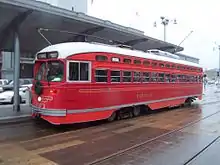 |
| 1062 | Pittsburgh Railways | In service | Built in 1948 for Philadelphia Transportation Company (later SEPTA) as 2101. Acquired by Muni in 1992 and re-entered service in 1995 with Louisville Railway livery. Rebuilt Brookville (2017);[62] returned with Pittsburgh livery.[75][73] | .jpg.webp) |
| 1063 | Baltimore Transit Company | Out of service | Built in 1948 for Philadelphia Transportation Company (later SEPTA) as 2096. Acquired by Muni in 1992 and re-entered service in 1995. Rebuilt by Brookville in 2017 and returned with alternate and more accurate Baltimore livery. It was damaged in a collision with a truck in January 2018, shortly after returning to revenue service.[76] |  |
Second batch (overhauled by Brookville Equipment Corp.)
All of these cars were purchased by Twin Cities Rapid Transit in 1946. They were sold to Newark in 1953 and ran on the Newark City Subway until replacement by modern light rail vehicles in 2001. The San Francisco Municipal Railway acquired these cars in 2004[77] and had the cars overhauled at Brookville Equipment Corporation. Some of the cars were put in service in early 2007, but were taken out of service for wiring problems. These problems were eventually repaired. All these cars are single-end cars.
| PCC # | City/System Represented | Current Status | Notes | Image |
|---|---|---|---|---|
| 1070 | Newark City Subway | In service | First sent to San Francisco in 2002 as a trial to evaluate condition. Nicknamed "Ruby Slippers" for its red wheels.[77] |  |
| 1071 | Twin City Rapid Transit | In service | .jpg.webp) | |
| 1072 | Mexico City (STE) | In service |  | |
| 1073 | El Paso-Juarez | In service |  | |
| 1074 | Toronto Transit Commission | In service | .jpg.webp) | |
| 1075 | Cleveland Transit System | In service |  | |
| 1076 | Washington, DC | Out of service |  | |
| 1077 | Birmingham, Alabama | In service | 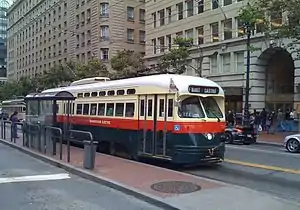 | |
| 1078 | San Diego | In service |  | |
| 1079 | Detroit, Michigan | In service |  | |
| 1080 | Los Angeles (National City Lines) | In service |  |
Third batch of rehabilitated San Francisco PCC cars
The following shows cars acquired by Muni in 1948 and 1952 that were restored or are in restoration and are either in service or will enter service within the next year. Car 1040 was restored in this batch and is the last PCC car ever built in North America.
| PCC # | City/System Represented | Status | Notes | Image |
|---|---|---|---|---|
| 1006 | San Francisco (wings) | In service | This car was purchased in 1948 and ran in San Francisco until retirement in 1987. Underwent restoration at Brookville Equipment. Returned to service on October 6, 2012. |  |
| 1008 | San Francisco (wings) | In service | This car was purchased in 1948 and ran in San Francisco. It was outfitted with a pantograph and used for testing in the Market Street Subway in November 1977 - the only PCC car to enter the subway.[78] It was eventually converted into a work car, then restored by Brookville Equipment and returned to service on August 25, 2012. | .jpg.webp) |
| 1009 | Dallas Terminal & Railway | In service | This car was purchased in 1948 and ran in San Francisco until retirement in 1982. This car was stored in Pier 72 where it was damaged by arsonists. It was eventually restored by Brookville Equipment and returned to service on January 17, 2013. However, the computerized door motors proved problematic and 1009 returned to Brookville for a refit, returning to San Francisco in 2014.[79] |  |
| 1011 | San Francisco (Market Street Railway zip stripe) | In service | This car was purchased in 1948 and ran in San Francisco until retirement in 1982. This car was stored in Pier 72 where it was damaged by arsonists. 1011 was the last of the four double-enders restored at Brookville, and eschewed the computerized door motors after operating experience proved they were unreliable.[80] It returned to San Francisco after an extensive testing period at Brookville and underwent burn-in testing[81] before re-entering service in 2014. | .jpg.webp) |
| 1040 | San Francisco (wings) | In service | Purchased 1952 as the last PCC streetcar ever built in the United States. Ran in San Francisco wearing this paint scheme until repainted to Landor livery in 1980. Remained in service until the retirement – originally expected to be permanent – of all remaining PCC cars in September 1982, then was repainted back to wings livery and returned to service for the summer 1983 Historic Trolley Festival. Stored out of service in 1987, then operated in tripper service in 1995 for a short time, then finally retired in 1997. 1040 left San Francisco on December 4, 2009, to undergo a full restoration at Brookville Equipment Corporation in Pennsylvania and returned to service on March 13, 2012. |  |
10xx class
The following shows the inactive 10s, PCC streetcars assigned numbers 10xx that were largely acquired by Muni in the 1940s to 1952 which have yet to be restored.[82][83] This also includes two streetcars that were acquired from other systems in the early 1990s: 1054 (ex-SEPTA 2121), which was damaged beyond repair in 2003 after rehabilitation, and 1064 (ex-SEPTA 2133), which was never rehabilitated after acquisition.
| PCC # | City/System Represented | Status | Notes | Image |
|---|---|---|---|---|
| 1014 | San Francisco | Loan | Double-ended torpedo, retired in 1982; on long-term loan to Sydney Tramway Museum.[84][85] | 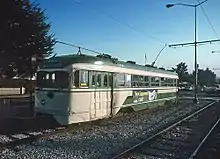 |
| 1026 | San Francisco | Stored | .jpg.webp) | |
| 1027 | San Francisco | Stored | .jpg.webp) | |
| 1028 | San Francisco | Stored |  | |
| 1033 | San Francisco | Stored | Purchased 1952 as the seventh-to-last PCC streetcar ever built in the United States. Ran in San Francisco until retirement in 1982. After retirement, it was sold to Orange Empire Railway Museum. The car was reacquired in 2003 and is currently stored in Marin Division. |  |
| 1034 | San Francisco | Stored | Purchased 1952 as the sixth-to-last PCC streetcar ever built in the United States. Ran in San Francisco until retirement in 1982. After retirement, it was sold to Gunnar Henrioulle in Lake Tahoe. The car was reacquired in 2001 and is currently stored in Marin Division. |  |
| 1039 | San Francisco (Simplified) | Stored | Purchased 1952 as the second-to-last PCC streetcar ever built in the United States. Ran in San Francisco until retirement in 1982. After retirement, it was sold to Orange Empire Railway Museum. The car was reacquired in 2003 and is currently stored in Marin Division. | |
| 1054 | Philadelphia Transit Commission (PCC-1938 Livery) | Permanently out of service | Purchased in 1948 by Philadelphia Transportation Company (PTC) as 2121 and ran until retirement in 1988. Sold to San Francisco Municipal Railway in 1992 and returned to service in 1995 until damaged beyond repair following a collision with a MUNI Metro Breda LRV (#1541) on Nov 16, 2003.[56] Stored in Marin Division. Listed for potential disposal in May 2018, with plans to save the undamaged front half.[86] |  |
| 1064 | Philadelphia Transportation Company | Stored | This was SEPTA's demonstration streetcar before the F-line's inception.[84] Purchased by PTC in 1946 as 2133; acquired by Muni in 1990 and renumbered to 1064 but never re-entered service. Stored in Marin Division; listed for disposal in May 2018 with significant structural rust.[86] |
11xx class
The 1100s series of cars were purchased in 1957 by Muni from St. Louis Public Service. These cars were retired in 1982, with most being sold off to Tahoe Valley Lines and then went to St. Charles, Missouri in 2007 for the planned St. Charles City Streetcar.[11]
| PCC # | City/System Represented | Status | Notes | Image |
|---|---|---|---|---|
| 1103 | San Francisco | Stored |  | |
| 1106 | San Francisco | Listed for potential disposal in May 2018 with significant structural rust.[86] | ||
| 1108 | San Francisco | Listed for potential disposal in May 2018 with significant structural rust.[86] | .jpg.webp) | |
| 1115 | San Francisco | .jpg.webp) | ||
| 1125 | San Francisco | Listed for potential disposal in May 2018 with significant structural rust.[86] |  | |
| 1128 | St. Louis Public Service | Renumbered and repainted 1982/83 as St. Louis 1704, its original identity, for use in the Historic Trolley Festival | 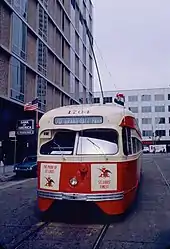 | |
| 1130 | San Francisco | |||
| 1139 | San Francisco | Listed for potential disposal in May 2018 with significant structural rust.[86] |  | |
| 1140 | San Francisco | Listed for potential disposal in May 2018 with significant structural rust.[86] | ||
| 1158 | San Francisco |  | ||
| 1160 | San Francisco | .jpg.webp) | ||
| 1168 | San Francisco |  | ||
Milan "Peter Witt" trams
These Peter Witt streetcars were originally in service in Milan, Italy.[11] This origin can still be seen in the cars, as all the original Italian signs and notices are still in place. In the meantime, additional signs in English were added.
| Car # | Livery | Status | Image |
|---|---|---|---|
| 1807 | Milan, Italy (Yellow/White) | Out of service |  |
| 1811 | Milan, Italy (Yellow/White) | Out of service |  |
| 1814 | Milan, Italy (Two-tone green) | In service | .jpg.webp) |
| 1815 | Milan, Italy (Orange) | In service | .jpg.webp) |
| 1818 | Milan, Italy (Two-tone green) | In service |  |
| 1834 | Milan, Italy (Orange) | Undergoing restoration |  |
| 1856 | Milan, Italy (Orange) | In service |  |
| 1859 | Milan, Italy (Orange) | Out of service |  |
| 1888 | Milan, Italy (Two-tone green) | Undergoing repair | 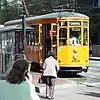 |
| 1893 | Milan, Italy (Orange) | Out of service |  |
| 1895 | Milan, Italy (Orange) | Out of service |  |
San Francisco
The following shows trams that operated in San Francisco before the 1950s under either San Francisco Muni or Market Street Railway.
| Car # | City of Origin (Car's Paint Scheme Colors) | Status | Notes | Image |
|---|---|---|---|---|
| 1 | San Francisco (Battleship Gray) | In service | This car was purchased in 1912 as one of the original streetcars publicly owned by Muni. The car originally was retired in 1951 and was set aside for a museum. This car was restored in 1962 as part of Muni's 50th anniversary and ran occasionally on special excursions until the late 1980s. This car was restored again in 1995 for the opening of the F-line. In 2009 it was shipped to Brookville Equipment Corporation for a complete restoration at a cost of $1.8 million. This streetcar returned to service on October 6, 2012.[87] |  |
| 130 | San Francisco (Blue/Gold) | Out of service | This car was purchased in 1914 as part of a 100-car order from Jewett Car Company. This car ran in San Francisco until retirement in 1958. It was converted into a wrecker and was restored to blue and gold colors in 1983. In 2002, No. 130 was dedicated to longtime San Francisco Chronicle columnist Herb Caen.[88] |  |
| 162 | San Francisco (Wings) | Out of service | This car was purchased in 1914 as part of a 125-car order from Jewett Car Company. This car ran in San Francisco until retirement in 1958 and was then sold with another car to Orange Empire Railway Museum. It was reacquired in 2003 by the San Francisco Municipal Railway and restored by Market Street Railway in 2004. The car then underwent further restoration by Muni starting in 2005 and returned to service in August 2008, the 50-year anniversary of its earlier retirement.[89] On January 4, 2014, this car was involved in a collision with a container truck, seriously damaging one of its ends.[90] Rebuilt in Long Beach and returned to Muni in April 2018.[91] |  |
| 578-S | Market Street Railway | Charter service only | Built in 1896 by Hammond Car Company in San Francisco; converted to a work car after the 1906 San Francisco earthquake and renumbered to 0601.[92] Restored to original appearance in 1956 and permanently loaned to the Western Railway Museum, but recalled by Muni in 1984 to serve in Trolley Festivals.[92][93] |  |
| 798 | Market Street Railway (Whiplash Green/White) | Undergoing restoration at Curtis E. Green complex | Built in 1924 by the Market Street Railway at Elkton Shops (now Green Division at Ocean & San Jose). Sold for scrap in 1946 and eventually became a jewelry store in Columbia before being repurchased in 1984 using money donated by Embarcadero Center[94] and returned to Muni. Only surviving streetcar of the class operated by Maya Angelou.[95] Moved to Cameron Beach Yard in 2011.[96] |  |
United States
The following shows trams (including PCCs) which have operated elsewhere in the United States. Some of these are not in service, and even require extensive restoration.
| Car # | City of Origin (Car's Paint Scheme Colors) | Status | Notes | Image |
|---|---|---|---|---|
| 18 | Philadelphia, Pennsylvania | Under restoration | Both of these double-ended PCCs were built in 1949 by St. Louis Car Co. for Philadelphia Suburban Transportation (later SEPTA), retired in 1982,[97][98] and acquired from Shore Line Trolley Museum in 2017 for $196,000; in return, Cable Car No. 28 was donated to Shore Line in 2018. The PCCs were sent from Shore Line to Brookville for rehabilitation in June 2017.[99] | |
| 21 | ||||
| 351 | Johnstown,Pennsylvania (Orange/Cream) | Awaiting overhaul | Intended restoration as a teaching trolley. Originally built in 1926 with rattan seats and wood trim.[100] | .jpg.webp) |
| 913 | New Orleans, Louisiana (Green) | Awaiting overhaul | Originally built in 1923 as one of 73 in its class by Perley Thomas; sold as surplus in 1964 to the Orange Empire Railway Museum; purchased by Muni in 2005.[101] | .jpg.webp) |
| 952 | New Orleans, Louisiana (Green) | Out of service | Originally built in 1923 as one of 73 in its class by Perley Thomas; sold as surplus in 1964 and repurchased from Chattanooga by New Orleans in 1984. Retired again in 1997 when replaced by replica; leased to San Francisco in 1998.[101] | 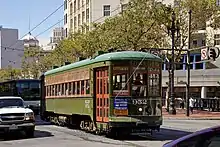 |
| 2147 | Philadelphia, Pennsylvania | Stored | This was acquired as a parts car for the 1050-class PCC fleet, and has a different propulsion from the current fleet.[84] This car is notable for being the only PCC car to ever operate in New Orleans. | |
| 4008 | Pittsburgh, Pennsylvania | Stored | Port Authority 4000 Series PCC, originally built for the Pittsburgh Railways Company, later the Port Authority of Allegheny County. When portions of Port Authority's streetcar system were being rebuilt and modernized in the 1980s, 45 of the Authority's PCC's were to be completely rebuilt as well. However, due to budget problems, only a dozen were actually rebuilt, including 4008 and 4009. After the Overbrook Line's closure in 1993, these cars were relegated to a shuttle service between the Drake Loop and Castle Shannon until retirement in 1999. Purchased at auction in 2001, Nos. 4008 and 4009 are stored and require re-gauging[84] as well as modifications to make them ADA-compliant. Listed for potential disposal in May 2018 with significant structural rust; Muni intends to donate them whole as they are complete.[86] | |
| 4009 |
The rest of the world
Trams acquired from outside the United States:
| Car # | City of Origin (Car's Paint Scheme Colors) | Status | Notes | Image |
|---|---|---|---|---|
| 106 | Moscow/Orel, Russia (Red) | Stored awaiting restoration | "Streetcar Named Desire for Peace",[102] gifted to Mayor Dianne Feinstein by the Soviet Union[103] through the efforts of Maury Klebolt.[104] Last ran in 1992 for the parade celebrating the 100th anniversary of streetcar service in San Francisco.[105] | .jpg.webp) |
| 151 | Osaka, Japan | Stored awaiting restoration | Built by Kawasaki in 1927; arrived in San Francisco in 1988.[106] Restoration prioritized over 578j because 151 is from sister city (Osaka) and has four motors, making it more suitable for service.[107] |  |
| 189 | Porto, Portugal | Undergoing restoration | Copy of a J. G. Brill Company streetcar design, built in 1929. Purchased in 1984 from Paul Class after running in the first (1983) San Francisco Historic Trolley Festival. Last run in 1987.[108] | 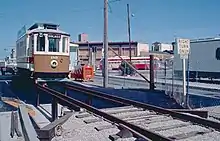 |
| 228 | Blackpool, England (Green/White) | Operational | Distinctive open-air "boat" car, one of twelve built for Blackpool Transport in 1934. Brought to San Francisco in 1984.[109][110] |  |
| 233 | Blackpool, England (Green/White) | Operational | Open-air boat car, one of twelve built for Blackpool Transport in 1934. Declared surplus in 2010[110] and purchased from Lancastrian Transport Trust in 2013.[109] | .jpg.webp) |
| 496 | Melbourne, Australia (Green/Beige) | Operational | W2-class, first operated in Feb 1928. Purchased by Muni in 1984 with No. 586.[111] As of 2018, regularly operates weekends on E Line, which requires double-ended cars, because there is no turnaround at the southern terminus.[112] |  |
| 578-J | Kobe/Hiroshima, Japan | Undergoing restoration | Originally built in 1927 as No. 574, one of the 570 streetcar class for the Kobe City Railways. Acquired by Hiroshima Electric Railway in 1971 when Kobe City Railways closed; later brought to San Francisco in 1986 for the Trolley Festival that year.[113] |  |
| 586 | Melbourne, Australia (Green/Beige) | Out of service | W2-class. Is a parts car for 496.[111] Donated its trucks for car 916; trucks underwent refurbishment and were fitted to car 916 in February 2018. | |
| 737 (7037) | Brussels, Belgium | Operational | This car's original service career was spent on the Brussels, Belgium streetcar system as No. 7037, starting in 1952. Arrived in San Francisco in June 2004 and repainted in the blue-and-white paint scheme of the Verkehrsbetriebe Zürich, as Zurich, Switzerland, is a sister city of San Francisco, entering Muni service in 2005.[114] Has seen only limited service because it has specialized parts and is a narrow streetcar, limiting capacity. |  |
| 916 | Melbourne, Australia (Green/Beige) | Operational | SW6-class. Entered service in 1946; donated by State of Victoria to San Francisco in 2009.[115] Awaited modifications necessary to operate on E and F line from 2009 to 2018. In early February 2018, No. 916 received its permanent trucks and final modifications. It awaits CPUC inspection. |  |
| 3557 | Hamburg, Germany (Red/White) | Stored awaiting potential restoration | Built in 1954; V6E class. Retired in 1978 when the Hamburg streetcar system was abandoned; arrived in San Francisco in 1979. Delivered to City Hall as a surprise, leading to the headline "A Streetcar Named Undesirable".[116] Last ran in 1992. Major structural revisions necessary for ADA requirements.[117] | 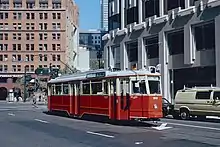 |
See also
References
- McKane, John; Perles, Anthony (1982). Inside Muni: The Properties and Operations of the Municipal Railway of San Francisco. Interurban Press. ISBN 978-0916374495.
- "Fiscal Year 2008 Short Range Transit Plan: Chapter 7" (PDF). San Francisco Metropolitan Transportation Agency. Archived from the original (PDF) on February 5, 2009. Retrieved December 25, 2007.
- Rhodes, Michael (28 May 2010). "Muni Gets First Two Refurbished Buses Back from the Shop". Streetsblog San Francisco. Retrieved 17 May 2018.
- "SFMTA Unveils Rehabilitated Neoplan Bus". archives.sfmta.com. Retrieved 17 May 2018.
- RODRIGUEZ, JOE FITZGERALD (2018-02-14). "SFMTA prepares to replace miniature Muni buses". SF Examiner. Retrieved 2020-07-15.
- "Balky new bus spoils Muni's show". The San Francisco Chronicle.
- Rodriguez, Joe Fitzgerald (April 18, 2017). "Muni's worst clunker buses to be replaced for big price tag: $244M". San Francisco Examiner. Retrieved 2017-05-09.
- Trolleybus Magazine No. 329 (September–October 2016), p. 159. National Trolleybus Association (UK). ISSN 0266-7452
- Breda Specification Sheet
- "E-Line Finally Budgeted...For 2016!". Market Street Railway. Retrieved March 31, 2014.
- "Museums in Motion: F-line fleet operational status". Market Street Railway. Retrieved December 27, 2007.
- Haseldine, Peter, ed. (January–February 2020). "Trolleynews". Trolleybus Magazine. Vol. 56 no. 349. UK: National Trolleybus Association. p. 37. ISSN 0266-7452.
- "Muni's Electric Trolley Buses". San Francisco Municipal Transportation Agency. Retrieved February 8, 2020.
- http://www.cs-dopravak.cz/zpravy/2019/9/13/je-konec-esk-trolejbusy-v-san-francisku-jsou-minulost
- Rodriguez, Joe Fitzgerald (May 29, 2019). "Transit enthusiasts rally to rescue 'rare' Muni bus headed for auction: 1994 New Flyer one of the last vehicles of its kind". San Francisco Examiner. Retrieved 31 May 2019.
- "1993 New Flyer Electric E60 Transit Bus". Archived from the original on May 29, 2019.
- "1991 New Flyer Articulated D60 Muni Bus". Archived from the original on May 31, 2019.
- "Muni NX Buses To Be Replaced With Hybrids". San Francisco Examiner. Retrieved December 14, 2013.
- "Taking the Bus: Muni Vehicles End Up in the Darndest Places". SF Weekly. Retrieved November 21, 2012.
- "SFMTA Renames Historic Streetcar Yard for Cameron Beach" (Press release). San Francisco Municipal Transportation Agency. 25 October 2011. Retrieved 3 October 2018.
- Nolte, Carl (29 October 2003). "David L. Pharr -- expert restorer of S.F. streetcars". San Francisco Chronicle. Retrieved 3 October 2018.
- "Back in Business". Market Street Railway. July 27, 2008. Retrieved 3 October 2018.
- Iacuessa, Michael (December 2017). "Islais Creek SFMTA Facility Fails to Deliver on its Promises". Potrero View.
- "SFMTA Explores Double Deck bus option". San Francisco Metropolitan Transportation Agency. December 2017.
- Bialick, Aaron (2015-12-20). "Switch to Renewable Diesel Will Make Your Muni Ride Cleaner & More Reliable". SFMTA. Retrieved 2019-10-14.
- Meriwether, Douglas (2015). The Dao of Doug 2: The Art of Driving A Bus / Keeping Zen in San Francisco Transit: A Line Trainer's Guide. Balboa Press. ISBN 9781452522821.
- "Hybrid Diesel Electric Transit Buses". Maryland Transit Administration. Retrieved April 6, 2013.
- Muni's 'Connected Bus' is about to go online
- Gordon, Rachel (March 7, 2008). "Vandals halt some hybrid buses in Hunters Point". San Francisco Chronicle. Retrieved April 6, 2013.
- "San Francisco Commits To All-Electric Bus Fleet By 2035". San Francisco Municipal Transportation Agency. 2018-05-18. Retrieved 2020-04-28.
- "San Francisco Commits To All-Electric Bus Fleet By 2035" (Press release). San Francisco Municipal Transportation Agency. May 15, 2018.
- "Resolution No. 191105-137" (PDF). Board of Directors, San Francisco Municipal Transportation Agency. November 5, 2019. Retrieved 13 December 2019.
- Murray, Alan (2000). World Trolleybus Encyclopaedia, p. 79. Yateley, Hampshire, UK: Trolleybooks. ISBN 0-904235-18-1.
- "Tom's North American (Canada, USA, Mexico) Trolleybus Pix". Retrieved December 25, 2007.
- "General Information About Transit". San Francisco MTA. Archived from the original on January 28, 2013. Retrieved December 28, 2012.
- Perles, Anthony (Fall 1984). "8: Muni up to Date". Tours of Discovery: A San Francisco Muni Album. Glendale, California: Interurban Press. ISBN 0-916374-60-2.
- Box, Roland (May–June 1989). "San Francisco Looks Ahead". Trolleybus Magazine No. 165, pp. 50–56. National Trolleybus Association (UK).
- Trolleybus Magazine No. 195 (May–June 1994), p. 83.
- Trolleybus Magazine No. 259 (January–February 2005), p. 23.
- "Tom's Trolley Bus Pictures San Francisco CA Fixed Frame". Retrieved December 25, 2007.
- Rachel Gordon (December 3, 2007). "Elite craftsmen keep S.F. cable car in good shape". San Francisco Chronicle/SFGate. Retrieved 2007-12-26.
- Kirschbaum, Julie (November 19, 2019). LRV4 Project Update (PDF) (Report). San Francisco Municipal Transportation Agency. Retrieved 9 December 2019.
- Cabanatuan, Michael. "$1.2 billion contract OKd for new Muni Metro light-rail cars". San Francisco Chronicle. Retrieved 5 August 2014.
- "Resolution No. 170620-081" (PDF). San Francisco Municipal Transportation Agency, Board of Directors. June 20, 2017. Retrieved 13 December 2019.
- "Resolution No. 15-019" (PDF). San Francisco Municipal Transportation Agency, Board of Directors. July 15, 2014. Retrieved 13 December 2019.
- "Resolution No. 14-120" (PDF). San Francisco Municipal Transportation Agency, Board of Directors. July 15, 2014. Retrieved 13 December 2019.
- "First New Muni State-of-the-Art Train Makes Debut in Service" (Press release). San Francisco Municipal Transportation Agency. November 17, 2017. Retrieved March 5, 2018.
- Lelchuk, Ilene (14 January 2002). "Muni cars on a roll into city junkyard / Even preservationists reject the clunkers". San Francisco Chronicle. Retrieved 21 April 2017.
- Rodriguez, Joe Fitzgerald (31 March 2016). "Last of Muni's 1980's-era clunker trains will be scrapped". San Francisco Examiner. Retrieved 4 May 2017.
- Sheridan, Kevin (20 November 2006). "SFmuni1271". flickr. Retrieved 21 April 2017.
- 2014 SFMTA Transit Fleet Management Plan (PDF) (Report). San Francisco Municipal Transportation Agency. March 2014. Retrieved 18 December 2018.
- Chinn, Jerold (November 9, 2018). "Muni strides toward early retirement for aging Breda trains". SFBay. Retrieved 18 December 2018.
- Railroad Accident Brief RAB-11-04, Accident No. DCA-09-FR-010 (PDF) (Report). National Transportation Safety Board. April 13, 2011.
- "Contract No. CPT 626.02, LRV Collision Repairs" (PDF). San Francisco Municipal Transportation Agency. 2009. Retrieved 13 December 2019.
- https://sfbayca.com/2017/07/20/muni-train-garbage-truck-collide-in-bayview/
- "Car 1054" (PDF). Inside Track Newsletter. Market Street Railway. Winter 2004.(subscription required)
- Walsh, Diana (17 November 2003). "3 Muni employees injured in collision". San Francisco Chronicle. Retrieved 22 March 2017.
- "'Ruby Slippers' Dances along the F-line Again". Market Street Railway. 17 March 2012. Retrieved 22 March 2017.
- "Kansas City, Outta Here!". Market Street Railway. 21 October 2014. Retrieved 22 March 2017.
- "Third PCC Goes Into Rehab". Market Street Railway. 6 June 2015. Retrieved 22 March 2017.
- Flores, Joseph; Sheridan, Kevin (17 May 2016). Trip Report - Brookville ex-SEPTA PCC Overhaul, May 2016 (PDF) (Report). San Francisco Municipal Railway. Retrieved 22 March 2017.
- "Second Renovated PCC Back From Contractor". Market Street Railway. 10 November 2016. Retrieved 19 March 2017.
- "Welcome Back, Harvey Milk's Streetcar!". Market Street Railway. 15 March 2017. Retrieved 22 March 2017.
- SEPTA Pasts of F-Line PCCs 1050-1063
- "Muni Streetcar No. 1051 Dedicated to Supervisor Harvey Milk" (Press release). Market Street Railway. 29 October 2008. Retrieved 19 March 2017.
- "San Francisco Welcomes the Harvey Milk Streetcar Back Into Service" (PDF) (Press release). San Francisco Municipal Transportation Agency. 15 March 2017. Retrieved 19 March 2017.
- Nahmod, David-Elijah (16 March 2017). "Restored, Re-Dedicated Harvey Milk Streetcar Returns To The Streets". Hoodline. Retrieved 19 March 2017.
- "Brooklyn is back". Market Street Railway. 6 April 2018. Retrieved 26 August 2018.
- "Our Spies are Everywhere!". Market Street Railway. 29 August 2017. Retrieved 7 December 2017.
- "Boston's Back in Business". Market Street Railway. 20 May 2017. Retrieved 7 December 2017.
- "Historic San Francisco PCC cars to be rebuilt". Trains Magazine. Trains Magazine. Retrieved 11 November 2014.(subscription required)
- "Kansas City PCC 1056 Back at Muni". Market Street Railway. 26 August 2016. Retrieved 22 March 2017.
- "Perfect November Saturday on the Waterfront". Market Street Railway. 18 November 2017. Retrieved 7 December 2017.
- Laubscher, Rick (26 October 2017). "Baltimore Blues". Market Street Railway. Retrieved 7 December 2017.
- "Pittsburgh in Nevada, Inbound". Market Street Railway. 24 June 2017. Retrieved 7 December 2017.
- ""Newest" PCC Streetcar Collides with Truck". Market Street Railway. January 2, 2018.
- "No. 1070: Newark, NJ". Market Street Railway. Retrieved 10 February 2019.
- Perles, Anthony (1981). The People's Railway: The History of the Municipal Railway of San Francisco. Interurban Press. p. 234. ISBN 0916374424.
- "On Donner!". Market Street Railway. 28 February 2014. Retrieved 22 March 2017.
- "The Straggler May Finally Head Our Way". Market Street Railway. 9 September 2013. Retrieved 22 March 2017.
- "Last Renovated PCC Back in Town". Market Street Railway. 18 September 2013. Retrieved 22 March 2017.
- Prial, Frank J. (December 9, 2001). "New Life for Old Trolleys". The New York Times. Retrieved 2010-09-13.
- The 17th & 18th 'Vintage Cars?'
- "The Streetcar Fleet". Market Street Railway. Retrieved 23 May 2018.
- "The Trams of the Sydney Tramway Museum". Sydney Tramway Museum. Retrieved 27 June 2019.
- "Authorizing the disposal of 12 surplus vintage streetcars (PCC Nos. 1023, 1031, 1038, 1054, 1064, 1106, 1108, 1125, 1139, 1140, 4008 and 4009)" (PDF). San Francisco Municipal Transportation Agency. May 8, 2018. Retrieved 5 June 2019.
- "No. 1: San Francisco Municipal Railway". Market Street Railway. Retrieved 26 June 2018.
- "Car No. 130 Dedicated to Herb Caen" (Press release). Market Street Railway. 15 April 2002. Retrieved 19 March 2017.
- "No Way to Start Its Centennial Year!". Market Street Railway. 4 January 2014. Retrieved 26 June 2018.
- "Embarcadero clear following SF Muni streetcar, big-rig crash". ABC 7 News. 4 January 2014. Retrieved 26 June 2018.
- "Welcome Home, 162!". Market Street Railway. 23 April 2018. Retrieved 26 June 2018.
- "No. 578: Market Street Railway Company". Market Street Railway. Retrieved 26 June 2018.
- "Patriarch Streetcar Turns 120". Market Street Railway. 9 August 2016. Retrieved 26 June 2018.
- "Great Institutions Make Great Things Possible". Market Street Railway. Retrieved 26 June 2018.
- "No. 798: Market Street Railway Company". Market Street Railway. Retrieved 26 June 2018.
- "Safe From the Weather At Last". Market Street Railway. 2 November 2011. Retrieved 26 June 2018.
- "Southeastern Pennsylvania Transportation Authority 18". Branford Electric Railway Association. Retrieved 30 September 2019.
- "Philadelphia Suburban Transportation 21". Branford Electric Railway Association. Retrieved 30 September 2019.
- "Authorizing the donation of retired and surplus original Cable Car No. 28 to the Branford Electric Railway Association, a Connecticut charitable 501(c)(3) non-profit corporation, dba the Shore Line Trolley Museum" (PDF). San Francisco Municipal Transportation Agency. March 26, 2018. Retrieved 30 September 2019.
- "No. 351: Johnstown, Pennsylvania". Market Street Railway. Retrieved 23 May 2018.
- "No. 952: New Orleans, Louisiana". Market Street Railway. Retrieved 23 May 2018.
- "Great Video of 1992 Streetcar Centennial". Market Street Railway. 16 August 2015. Retrieved 23 May 2018.
- "From Russia, With Ink". Market Street Railway. 28 November 2011. Retrieved 23 May 2018.
- "Remembering a Trolley Titan". Market Street Railway. April 15, 2003. Retrieved 3 October 2018.
- "Happy 125th to San Francisco Electric Streetcars". Market Street Railway. 27 April 2017. Retrieved 23 May 2018.
- "No. 151: Osaka, Japan". Market Street Railway. Retrieved 23 May 2018.
- "What Have We Learned". Market Street Railway. 4 August 2008. Retrieved 23 May 2018.
- "No. 189: Porto, Portugal". Market Street Railway. Retrieved 23 May 2018.
- "New Boat Could Be on Display This Weekend". Market Street Railway. 30 October 2013. Retrieved 23 May 2018.
- "No. 228 & 233: Blackpool, England". Market Street Railway. Retrieved 23 May 2018.
- "No. 496: Melbourne, Australia (W2 Class)". Market Street Railway. Retrieved 23 May 2018.
- "Say 'G'day' to Melbourne on the E-line this weekend". Market Street Railway. 2 February 2018. Retrieved 23 May 2018.
- "No. 578j: Kobe & Hiroshima, Japan". Market Street Railway. Retrieved 23 May 2018.
- "No. 737: Zurich, Switzerland". Market Street Railway. Retrieved 23 May 2018.
- "No. 916: Melbourne, Australia (SW6 Class)". Market Street Railway. Retrieved 23 May 2018.
- Kilduff, Marshall (March 15, 1979). "A Streetcar Named Undesirable". San Francisco Chronicle. Retrieved 3 October 2018.
- "No. 3557: Hamburg, Germany". Market Street Railway. Retrieved 23 May 2018.
External links
- "On the F-line & E-line Right Now". Market Street Railway. 2017. Retrieved 15 March 2017.
- "The Streetcar Fleet". Market Street Railway. 2017. Retrieved 15 March 2017.
- Müller, Maren (April 2009). "Travel-Report: Tramride in San Francisco with heritage streetcars". Draemmli. Archived from the original on 21 July 2011. Retrieved 15 March 2017.
- Lappin, Todd (10 September 2014). "Purgatory Station: San Francisco's Boneyard for Zombie Streetcars". Medium. Re-form. Archived from the original on 12 September 2014. Retrieved 15 March 2017.
- CPTDB wiki about San Francisco Municipal Railway fleet not 100% accurate enough